The Economics and Statistics Division maintains archives of previous publications for accountability purposes, but makes no updates to keep these documents current with the latest data revisions from Statistics Canada. As a result, information in older documents may not be accurate. Please exercise caution when referring to older documents. For the latest information and historical data, please contact the individual listed to the right.
<--- Return to Archive
For additional information relating to this article, please contact:
April 12, 2019MULTIFACTOR PRODUCTIVITY GROWTH IN THE PROVINCES, 2017 Statistics Canada has released its provincial multifactor productivity and related variables for the business sector for 2016. Multifactor productivity measures are derived using a growth accounting framework that includes measures of how capital input and skills impact labour productivity growth. The residual portion of labour productivity growth that is not attributable to other factors is the multifactor productivity(MFP) measure. The multifactor productivity captures the efficiency by which inputs are used in productions, these can be associated with technological change, organizational change or economies of scale.
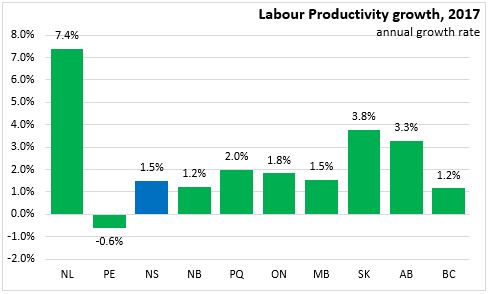
Labour productivity grew 1.5 per cent in Nova Scotia in 2017. Labour productivity growth was fastest in Newfoundland and Labrador (+7.4%), Saskatchewan (+3.8%), and Alberta (+3.3%) in 2017 as multifactor productivity increased in all three provinces after declines the previous year.
The growth in labour productivity can be decomposed into contributions from capital intensity (capital investment's effect on productivity), labour composition (education and experience effect) and the multifactor productivity that accounts for all other factors including technological change and changes in economies of scale. In 2017, multifactor productivity increased in all provinces with a 1.1 per cent increase in Nova Scotia.
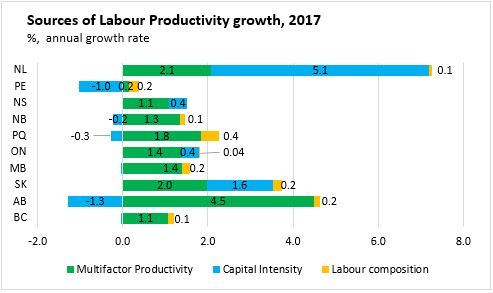
Across Nova Scotia business sector, average labour productivity growth was 1.5 per cent in 2017 with a 0.9 per cent increase in the goods sector and 1.8 per cent in the services sector. The contribution to labour productivity growth were a 1.1 per cent increase in multifactor productivity and a 0.4 per cent in capital intensity in production. The labour composition component was unchanged for the business sector aggregate.
Multifactor productivity had the largest increases in in manufacturing, wholesale, retail, information/culture, and accommodation/food services in 2017. Multifactor productivity declines contributed to lower labour productivity in mining, oil and gas extraction; agriculture, forestry, fishing; professional, scientific and technical services; and administrative and support services.
Capital intensity had notable increases in utilities, information and cultural; finance, insurance, and real estate; and arts, entertainment and recreation. Labour composition was up the most in arts, entertainment and recreation (+4.8%) while declining in wholesale, information and cultural, manufacturing, and mining, oil and gas extraction.
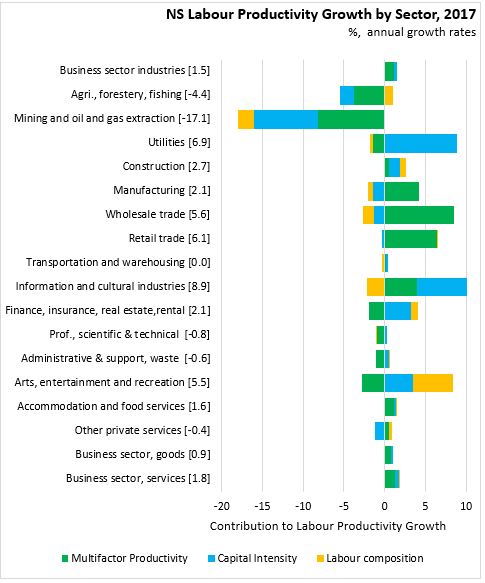
Over the period 1997-2017, Nova Scotia's labour productivity grew at an annual average rate of 1.2 per cent. The fastest labour productivity growth was in Manitoba and Newfoundland and Labrador while the slowest was in Alberta.
Since the global recession, multifactor productivity growth has improved in Canada compared to the decade prior. Canada's multifactor productivity has grown by annual average of 0.6 per cent over 2010 to 2017 compared to a decline of 0.6 per cent per year from 2000 to 2010. All provinces, except Newfoundland and Labrador experienced an improvement in multifactor productivity growth for 2010-2017 period compared to 2000-2010.
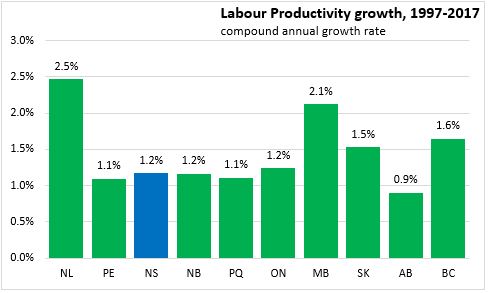

An improvement in multifactor and labour productivity growth in Nova Scotia has occurred over the past five years. Multifactor productivity growth has averaged of 0.9 per cent per year over 2012 to 2017 compared to a 0.6 per cent per year decline from 2007 to 2012. Along with contribution from rising capital intensity (+0.8%/year) and labour composition(+0.1%/year), labour productivity has grown 1.8 per cent per year from 2012 to 2017. In contrast, for the period from 2002 to 2012, multifactor productivity declined in 8 of 10 years and labour productivity growth averaged -0.2 per cent per year.
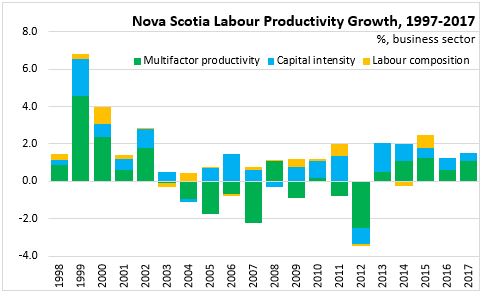
Over the past five years, multifactor productivity has been growing in the goods sector (+1.4%/year) with the exception of utilities and agriculture, forestry and fishing. Service sector multifactor productivity has been growing by 0.7 per cent per year for the 2012-2017 period with increases in wholesale, retail, transportation and warehousing, and information and cultural sectors. Rising capital intensity has made significant contributions to labour productivity growth in mining, oil and gas extraction; utilities; wholesale; information and cultural; finance and insurance; and real estate; and arts, entertainment and recreation. Labour composition contributions to labour productivity growth was largest in professional, scientific and technical services and agriculture, forestry and fishing.

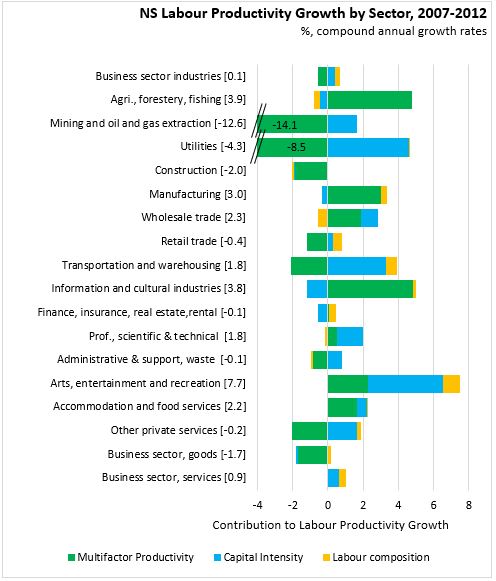
Estimates of multifactor productivity growth in the provinces, 2017
<--- Return to Archive